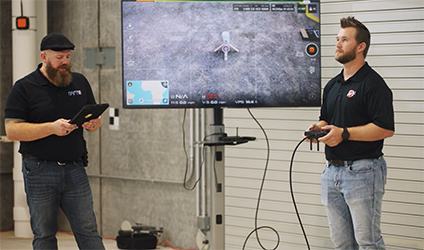
“Elevate to 15 feet above the landing pad. Perform a clockwise rotation 350 degrees. Acquire target A and announce when acquired.”
“Target A acquired.”
It sounds like a video game. Instead, this dialog was part of a drone challenge that took place at Oracle Industry Lab outside Chicago. As drones play a growing role in the construction industry, used for 3D photography, site scanning, equipment tracking, and more, firms are hiring drone pilots and investing in industrial-strength drones.
Four pilots took on the challenge at the lab, then sat for a roundtable session afterwards. Here are some insights from the pilots, Keaton Denzer from Bechtel Equipment Operations, Gregg Schkade from 3D-reality-capture firm VTS, Antoine Tissier from architecture and construction firm Clayco, and Bryan Prignano of Pepper Construction.
So how realistic is a preset course like the Lab’s compared with actually maneuvering around a live construction site or a structure like a cell phone tower?
“With drones we collect data faster, store it faster, transmit it back to home base faster, and then process it and create that digital twin, that 3-D model.”
— Gregg Schkade, Senior Capture, Lead Pilot and Data Lead, VTS
Much is the same, says Bechtel’s Keaton Denzer, who handles drone inspections on construction sites. In an environment filled with obstacles, such as cranes, towers, trucks—not to mention construction workers—it’s critical that drone operators are aware of where the drone is at all times, how fa st it’s flying, and how they’ll make quick inflight reorientations to get exactly the shot needed. “We can’t just fly and look everywhere,” says Denzer. “Everything has to have a purpose, every movement, every up/down, every spin.” Pepper Construction’s Bryan Prignano had a job recently where he flew a drone around high school chimneys, looking for cracks and damage to the brick work. “You’re just trying to keep the drone in sight, making sure you’re not getting too close or hitting anything, but getting good photos of the areas you’re trying to inspect,” Prignano says.
st it’s flying, and how they’ll make quick inflight reorientations to get exactly the shot needed. “We can’t just fly and look everywhere,” says Denzer. “Everything has to have a purpose, every movement, every up/down, every spin.” Pepper Construction’s Bryan Prignano had a job recently where he flew a drone around high school chimneys, looking for cracks and damage to the brick work. “You’re just trying to keep the drone in sight, making sure you’re not getting too close or hitting anything, but getting good photos of the areas you’re trying to inspect,” Prignano says.
This type of course can also be used to train drone operators, giving them the chance to practice, over and over, the moves they’ll need to perfect before using them in the real world. “It forces us to use those skill sets in a controlled environment,” VTS’s Gregg Schkade says. He developed the course with the goal of anticipating any type of challenge that exists in any industry that uses drones, which includes construction, communications, real estate, and agriculture, among others. “This type of exercise helps build up pilots’ skill sets and build up confidence,” Schkade says.
Keeping job sites safe
Worker safety is one key use case for drones across industries. The most obvious safety benefit is keeping people off roofs, ladders, and scaffolds, as drones take over inspections a person had to do up close. In addition, using drone-gathered data to create 2D maps, then converting those maps into 3D models helps site managers identify potential problems. Antoine Tissier, from Clayco’s virtual design and construction team, also emphasizes the safety benefits of planning. Tissier’s team uses drone data to plan the next step on a site so that project schedules and requirements are clear to everyone involved—including the subcontractors who are not always on the site from beginning to end. “When you plan something ahead, you don’t rush people, you don’t rush after time and money,” Tissier says. “That rush is usually where accidents happen.”
Schkade’s team frequently works on cell phone towers, where drones keep on-site workers on the ground and improve productivity. “With drones we collect data faster, store it faster, transmit it back to home base faster, and then process it and create that digital twin, that 3-D model,” says Schkade.
For Burcin Kaplanoglu, vice president of Oracle Innovation Lab, it all comes down to data. When drone-harvested data is paired with AI and advanced building information modeling systems, it will help generate a wave of operational improvements and insights. “These new technologies, with their ability to uncover and analyze tremendous amounts of data, will help transform project delivery by improving visibility, efficiency, and standardization,” says Kaplanoglu.
